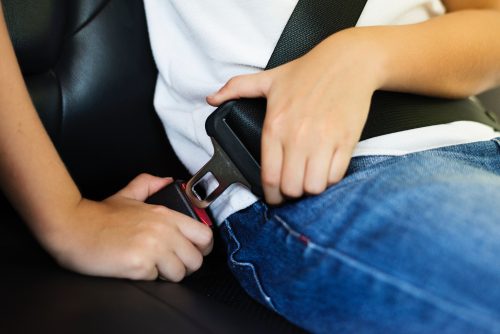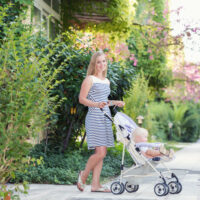As your kids get older they may want to ditch their booster seat in favor using the vehicle seat and seat belt. However, it is unsafe and probably uncomfortable to make this transition too soon.
Most children will need to remain in a booster seat until between the ages of 10 and 12.
Progressing to the vehicle seat too soon may cause these problems in the event of an accident:
- internal injuries to the abdomen
- head, neck and spinal injuries that are potentially fatal
We’ve reviewed the best booster seats here.
The 5-Step Test
The 5-step test is a checklist to find out whether your child is the right size to move from a booster seat to a standard vehicle seat.
If you answer “no” to any question in the 5-step checklist, then your child is not ready to get rid of the booster. Typically children pass the test when they are 4′ 9″ tall, but regardless of their height, you should do the test to be safe.
5-Step Test
- Is the child’s bottom flush against the back of the seat?
- With their bottom fully back against the seat do their knees bend over the front of the seat comfortably?
- Does the upper belt cross between their neck and shoulder?
- Does the lap belt cross at the hips, touching the thighs?
- the child comfortable enough to remain in this position for the trip?
Seat Belt Syndrome
The biggest enemy in an accident is momentum. When a vehicle is moving at 40 miles per hour and comes to an abrupt stop, momentum causes every object in the car to press forward with a force proportionate to the weight of the object.
A 50 lb. child moving at 40 miles per hour, will exert a force of 2,000 lbs against their seat belt or restraint system.
For a standard vehicle seat belt, all of that force is concentrated in the lap belt and shoulder belt areas.
Seat Belt Syndrome comes into play when the upper restraint is unused or improperly used. Children who are too small often tuck the upper belt under their arm or put it entirely behind their backs.
Without a proper upper belt restraint, in an accident, their upper torso is thrown forward. Their heads may impact the seat in front of them and be stopped, while their torso continues forward and snaps the neck or cause severe neck and spinal injury.
This effect has been observed far too often and was thus named “seat belt syndrome”.
For children, another aspect of seat belt syndrome is that the lap belt may cross their tummies instead of their hips if they are too small to be using the vehicle seat without a booster seat.
A seat belt too high on the abdomen may cause internal organ injuries that are much less likely with a lap belt positioned as low as possible across the hips.

Encouraging Safety
Your growing child is likely to want to do things they aren’t quite ready for from a safety perspective. This is natural and part of the maturation process.
There are several things you can do to help your child feel less self-conscious about staying in a “kid seat”.
- Emphasize vehicle safety from an early age.
- Always exercise safety yourself. Kids learn from what they see you doing more than from what you say.
- Take time to discuss the risks and consequences of unsafe practices.
- Show respect to your child by speaking to them as an adult. Let them know that although you view them as mature, their mental maturity and their body maturity may be very different things – and that’s okay!






